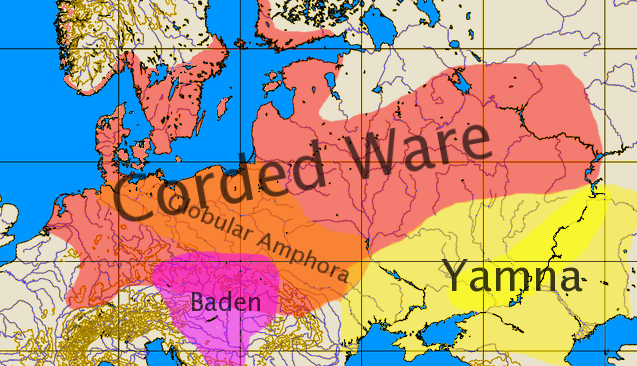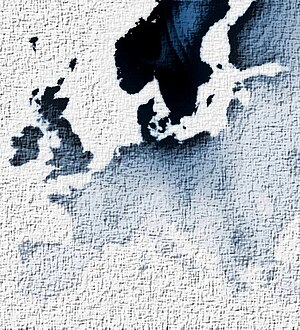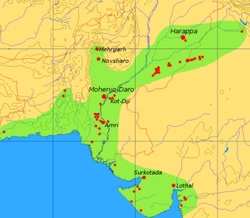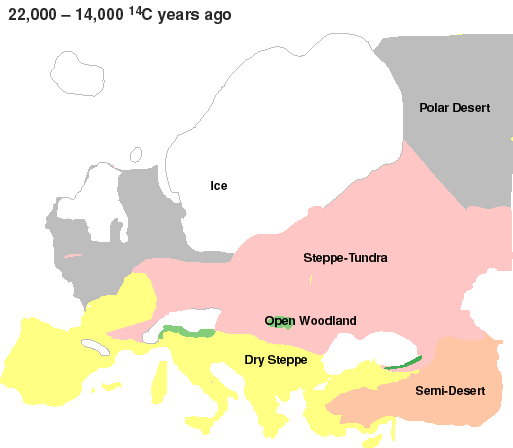Actually, J2 is more common in the south of India, which is more descended from the Dravidian rather than the Indo-Aryans.
links?
what about this one:
A principal-components plot of R1a1-M17 Y-microsatellite data (fig. 6) shows several interesting features: (a) one tight population cluster comprising southern Pakistan, Turkey, Greece, Oman, and West Europe; (b) one loose cluster comprising all the Indian tribal and caste populations, with the tribal populations occupying an edge of this cluster; and (c) Central Asia and Turkey occupy intermediate positions. The divergence time between the two clusters was 8–12 KYA. The pattern of clustering does not support the model that the primary source of the R1a1-M17 chromosomes in India was Central Asia or the Indus Valley via Indo-European speakers. Further, the relative position of the Indian tribals (fig. 6), the high microsatellite variance among them (table 12), the estimated age (14 KYA) of microsatellite variation within R1a1 (table 11), and the variance peak in western Eurasia (fig. 4) are entirely inconsistent with a model of recent gene flow from castes to tribes and a large genetic impact of the Indo-Europeans on the autochthonous gene pool of India. Instead, our overall inference is that an early Holocene expansion in northwestern India (including the Indus Valley) contributed R1a1-M17 chromosomes both to the Central Asian and South Asian tribes prior to the arrival of the Indo-Europeans. The results of our more comprehensive study of Y-chromosome diversity are in agreement with the caveat of Quintana-Murci et al. (2001, p. 541), that “more complex explanations are possible,” rather than their simplistic conclusion that HGs J and R1a1 reflect demic expansions of southwestern Asian Dravidian-speaking farmers and Central Asian Indo-European–speaking pastorialists.
http://www.ncbi.nlm.nih.gov/pmc/articles/PMC1380230/?tool=pmcentrez
Indian R1a1 cluster stretches through all castes and is clearly separated from R1a cluster of Europe, central Asia, Oman and Pakistan cluster...Anatolia cluster is in between...
now 8-12 KY before present is too far in past for Aryans...
this is not suggesting what I thought (that R1a1 comes from Indo-Scythians) but is also not in agreement that it comes from Indo-Aryans as it has entered all castes and much before Indo-Aryans...
besides if you followed my link where I talked of Indo-Aryans, you would see that my guess about J2 comes from archeological sites of Aryans matching well J2 spread...
We obviously do not know. But given how there's a correlation between four major branches of the Indo-European languages (Germanic, Balto-Slavic, Indo-Iranic and Tocharian), it makes things very likely that R1a was carried by the Indo-European migrations. I do not think that they were the only speakers of Indo-European languages because this does not account for three other major branches of Indo-European languages: Italo-Celtic, Greek and Anatolian - and in my opinion R1b-M269 is the best candidate for this.
Actually, there is enough R1a in Greece, Italy and Anatolia for language transfer.... so R1b is not needed for explanation....
There is absolutely no evidence that M269 was already inside Europe by the time PIE people are suggested to have entered Europe, as you claim. The oldest occurence of R1b in Europe thus far is from the Urnfield Culture (circa 1000 BC).
The linear pottery culture of the Neolithic for instance was shown to be G2a3: no R1b or R1a - both Haplogroups must have entered later.
ancient samples are taken in only few places and only very small number of samples...
if you sample now few graves in Finland and Sardinia you might conclude there is only N and I2a1 people in Europe...
In my opinion, R1b arrived in Europe with the Beaker-Bell Culture (it's the most likely candidate, in my opinion).
why don't you base your opinion on papers that estimate time of spread of R1b?
http://www.plosbiology.org/article/info:doi/10.1371/journal.pbio.1000285
after studying figure B we can expect that R1b1b2 entered Europe from Asia minor around 7500 - 8000 before present or 5500-6000BC which is much before estimated entrance of PIE speakers...
for example
"Saudi Arabian Y-Chromosome diversity and its relationship with nearby regions" - Khaled K Abu-Amero1 , Ali Hellani2 , Ana M González3 , Jose M Larruga3 , Vicente M Cabrera3 and Peter A Underhill4
http://www.biomedcentral.com/1471-2156/10/59
look for I*, I1* and I2* in this table
http://www.biomedcentral.com/1471-2156/10/59/table/T1
there is I* in Egypt, Lebanon, Jordan, Iraq, Anatolia and Pakistan...
not found in Iran according to this but I have seen other results for Iran as well... If there is I* in Pakistan, Persia should show some as well...
I1* and I2a* and I2b* are found in Anatolia which is basis for my assumption that haplgroup I was based in Anatolia for long time and spread to Europe in several waves - I1 as very early wave, I2b somewhat later, and I2a in the end...
Actually there is a lot of evidence backing this up. The age of the various subclades of Haplogroup I fits very well with the last glacial maximum. The only exception is Haplogroup I1, which appears to be the result of an extreme bottleneck: the last common ancestor of I1 correlates quite well with the arrival of the Battle Axe culture in Scandinavia - which was in itself an offshot of the Corded Ware Culture in Central Europe, which is known from ancient DNA samples to be R1a. Despite the last common ancestor I1 being so recent, the last common ancestor of I1 and I2 was near the last glacial maximum - this suggests that there was a massive population bottleneck in Scandinavia, which is also known from mitochondrial DNA samples:
Ancient DNA Reveals Lack of Continuity between Neolithic Hunter-Gatherers and Contemporary Scandinavians
so? that still doesnot mean that haplogroup I has originated in Europe as it obviously did not considering locations of I*, I1* and I2* in Anatolia and middle east...
and based on what you claim above, the I1 wave might have entered Europe as long ago as immediately after ice age.... as split between I1 and I2 obviously happened in Anatolia, where we find I1* and I2a* and I2b*, and as according to you time of split corresponds to last ice age...
I1 might have been decimated by spread of Battle Axe (R1a?), but that is in domain of guessing.... there could have been other reasons for being in that time close to extinction, e.g. some climate worsening.. hunger often moves peoples.... so Battle Axe expansion could have been also due to some sudden climate worsening...
anyway, can you quote the key sentences in paper that you link to that make basis for conclusions you made...
because already the title of the paper says something completely different - it says there is no continuity of today Scandinavians with neolithic inhabitants, while your story suggest I1 was there all along and it suffered from mean R1a battle axe invaders...
also please give links for estimations you give about earliest common ancestor of I1, and of earliest common ancestor for I1 and I2...
actually, considering lack of continuity between neolithic Scandinavians and modern ones....
I1 could have easily been brought to its current place by Corded ware/Battle axe, together with R1a...
based on few samples you conclude Battle Axe was R1a1 but we do not know if it also had abundance of I1...
correlation between battle axe and I1 spread seems quite good...
It is logarithmic, but apparently you didn't notice that certain other eruptions were of larger scales: Pinatubo (1991), Krakatoa (1883) were both level 6, and the Tambora (1815) was level 7, all of these were larger.
ok, good point...
but tell me how do you estimate amount of volcanic rocks of eruption of volcano 3200 years ago... estimation can easily be off tens of times....
it even does not have to be volcanic winter... maybe giant meteorite did fall somewhere and vulcano eruption was one consequence and 18 year old winter was other....
what we know is that there was 18 year long hunger recorded in time of the eruption of the volcano, and 18 year long winter in story of departure of Lydians to Umbria...
unlikelihood of 18 year old winter repeating several times in short time interval allows us to connect those two events with high probability....








